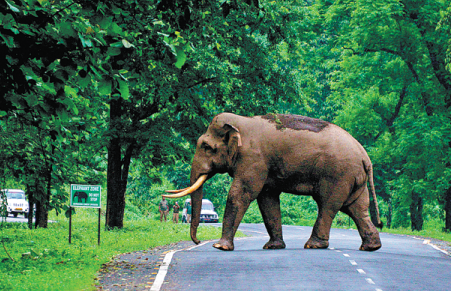India's elephants hoping for more room to move


The wandering elephants of China's Yunnan province have helped make many people in India-home to Asia's largest elephant population-more aware of the forest giants' roaming ways in the wild.
While the trek by a herd of Yunnan elephants over the past half year has made global headlines, in India it has rekindled discussions on how best to accommodate the migratory needs of the animals.
Elephants need to move, according to the Elephant Task Force, a body set up by the Indian government in 2010 to review the elephant conservation program and suggest new policy interventions. If the free-ranging giants do not do so, both the forests and the animals will perish, the advocates said.
The task force said elephants migrate in search of food and water and often settle into faraway places after their traditional habitats have been affected by climate change and human activities.
Their habitats have become severely fragmented, with highways, railway tracks, dams, new townships and other structures blocking old migration paths, said P. S. Easa, a member of the Elephant Task Force.
A recent survey by India's ministry of environment and forests revealed that elephants have been moving from the foothills in the northern state of Uttarakhand to the lower Himalayas, in just one such migration pattern.
The movement was first reported in June last year during the COVID-19 lockdown, and the migration from the foothills to lower Himalayas is still taking place, according to the survey.
Between 1993 and 1998, elephants moved from a prime habitat in Jharkhand state to the Chhattisgarh region, traveling around 350 kilometers and causing extensive damage to life and property, according to a study carried out by Project Elephant, a wildlife conservation initiative launched by India in 1992.
Since 2002, elephants have also been wandering regularly from the southern state of Karnataka to coastal Maharashtra, in western India, experts said.
In recent years, wild Asian elephants have frequently left protected areas and intruded into nearby villages, reflecting possible changes in dietary habits of the species or a degradation of habitats, said Sandeep Tiwari, program manager at the Asian Elephant Specialist Group of the International Union for Conservation-Species Survival Commission.
In India, the wild elephant population was estimated at about 27,000 last year, down sharply from a census in 2012, according to the ministry of environment and forests.
In February, when India hosted the United Nations Convention on the Conservation of Migratory Species, it was pointed out that "habitat loss, fragmentation, human-elephant conflict, poaching and illegal trade of elephants" are some of the main reasons for the drop in elephant numbers in India.
Protecting strategies
Members of the Elephant Task Force have suggested many strategies for protecting the natural habitats of elephants, but most are yet to be implemented, according to wildlife experts.
A study carried out by an international team of scientists in 2019 warned that elephants could lose nearly half of their habitats due to climate change by the end of this century.
This scenario would result in elephants shifting toward higher elevations, and along river valleys where there are extensive human settlements, the study said.
In 2010, India declared the elephant to be a national heritage animal. But an increasing number of human-elephant conflicts and severe loss of habitat are resulting in their migration and extinction, Tiwari said.
Aside from a proposal for a national elephant conservation authority along with more funds for conservation, India's Elephant Task Force has suggested the establishment of more corridors with fruit-bearing trees and water sources, and with reduced scope for encounters with people.
As for the Yunnan elephants, of the 17 that set out from their habitat in Xishuangbanna in the province's far south late last year, most of them remain on a journey that has taken them more than 500 km.
The writer is a freelance journalist for China Daily.



































